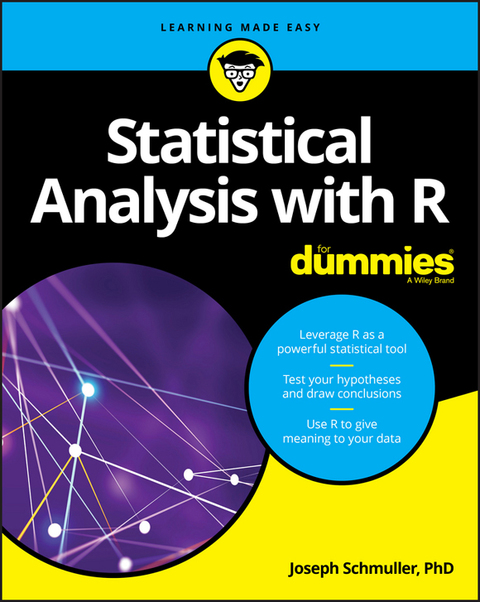Description
Efnisyfirlit
- Cover
- Introduction
- About This Book
- Similarity with This Other For Dummies Book
- What You Can Safely Skip
- Foolish Assumptions
- How This Book Is Organized
- Icons Used in This Book
- Where to Go from Here
- Part 1: Getting Started with Statistical Analysis with R
- Chapter 1: Data, Statistics, and Decisions
- The Statistical (and Related) Notions You Just Have to Know
- Inferential Statistics: Testing Hypotheses
- Chapter 2: R: What It Does and How It Does It
- Downloading R and RStudio
- A Session with R
- R Functions
- User-Defined Functions
- Comments
- R Structures
- Packages
- More Packages
- R Formulas
- Reading and Writing
- Part 2: Describing Data
- Chapter 3: Getting Graphic
- Finding Patterns
- Base R Graphics
- Graduating to ggplot2
- Wrapping Up
- Chapter 4: Finding Your Center
- Means: The Lure of Averages
- The Average in R: mean()
- Medians: Caught in the Middle
- The Median in R: median()
- Statistics à la Mode
- The Mode in R
- Chapter 5: Deviating from the Average
- Measuring Variation
- Back to the Roots: Standard Deviation
- Standard Deviation in R
- Conditions, Conditions, Conditions …
- Chapter 6: Meeting Standards and Standings
- Catching Some Z’s
- Standard Scores in R
- Where Do You Stand?
- Summarizing
- Chapter 7: Summarizing It All
- How Many?
- The High and the Low
- Living in the Moments
- Tuning in the Frequency
- Summarizing a Data Frame
- Chapter 8: What’s Normal?
- Hitting the Curve
- Working with Normal Distributions
- A Distinguished Member of the Family
- Part 3: Drawing Conclusions from Data
- Chapter 9: The Confidence Game: Estimation
- Understanding Sampling Distributions
- An EXTREMELY Important Idea: The Central Limit Theorem
- Confidence: It Has Its Limits!
- Fit to a t
- Chapter 10: One-Sample Hypothesis Testing
- Hypotheses, Tests, and Errors
- Hypothesis Tests and Sampling Distributions
- Catching Some Z’s Again
- Z Testing in R
- t for One
- t Testing in R
- Working with t-Distributions
- Visualizing t-Distributions
- Testing a Variance
- Working with Chi-Square Distributions
- Visualizing Chi-Square Distributions
- Chapter 11: Two-Sample Hypothesis Testing
- Hypotheses Built for Two
- Sampling Distributions Revisited
- t for Two
- Like Peas in a Pod: Equal Variances
- t-Testing in R
- A Matched Set: Hypothesis Testing for Paired Samples
- Paired Sample t-testing in R
- Testing Two Variances
- Working with F-Distributions
- Visualizing F-Distributions
- Chapter 12: Testing More than Two Samples
- Testing More Than Two
- ANOVA in R
- Another Kind of Hypothesis, Another Kind of Test
- Getting Trendy
- Trend Analysis in R
- Chapter 13: More Complicated Testing
- Cracking the Combinations
- Two-Way ANOVA in R
- Two Kinds of Variables … at Once
- After the Analysis
- Multivariate Analysis of Variance
- Chapter 14: Regression: Linear, Multiple, and the General Linear Model
- The Plot of Scatter
- Graphing Lines
- Regression: What a Line!
- Linear Regression in R
- Juggling Many Relationships at Once: Multiple Regression
- ANOVA: Another Look
- Analysis of Covariance: The Final Component of the GLM
- Chapter 15: Correlation: The Rise and Fall of Relationships
- Scatter plots Again
- Understanding Correlation
- Correlation and Regression
- Testing Hypotheses About Correlation
- Correlation in R
- Multiple Correlation
- Partial Correlation
- Partial Correlation in R
- Semipartial Correlation
- Semipartial Correlation in R
- Chapter 16: Curvilinear Regression: When Relationships Get Complicated
- What Is a Logarithm?
- What Is e?
- Power Regression
- Exponential Regression
- Logarithmic Regression
- Polynomial Regression: A Higher Power
- Which Model Should You Use?
- Part 4: Working with Probability
- Chapter 17: Introducing Probability
- What Is Probability?
- Compound Events
- Conditional Probability
- Large Sample Spaces
- R Functions for Counting Rules
- Random Variables: Discrete and Continuous
- Probability Distributions and Density Functions
- The Binomial Distribution
- The Binomial and Negative Binomial in R
- Hypothesis Testing with the Binomial Distribution
- More on Hypothesis Testing: R versus Tradition
- Chapter 18: Introducing Modeling
- Modeling a Distribution
- A Simulating Discussion
- Part 5: The Part of Tens
- Chapter 19: Ten Tips for Excel Emigrés
- Defining a Vector in R Is Like Naming a Range in Excel
- Operating on Vectors Is Like Operating on Named Ranges
- Sometimes Statistical Functions Work the Same Way …
- … And Sometimes They Don’t
- Contrast: Excel and R Work with Different Data Formats
- Distribution Functions Are (Somewhat) Similar
- A Data Frame Is (Something) Like a Multicolumn Named Range
- The sapply() Function Is Like Dragging
- Using edit() Is (Almost) Like Editing a Spreadsheet
- Use the Clipboard to Import a Table from Excel into R
- Chapter 20: Ten Valuable Online R Resources
- Websites for R Users
- Online Books and Documentation
- About the Author
- Connect with Dummies
- End User License Agreement






Reviews
There are no reviews yet.